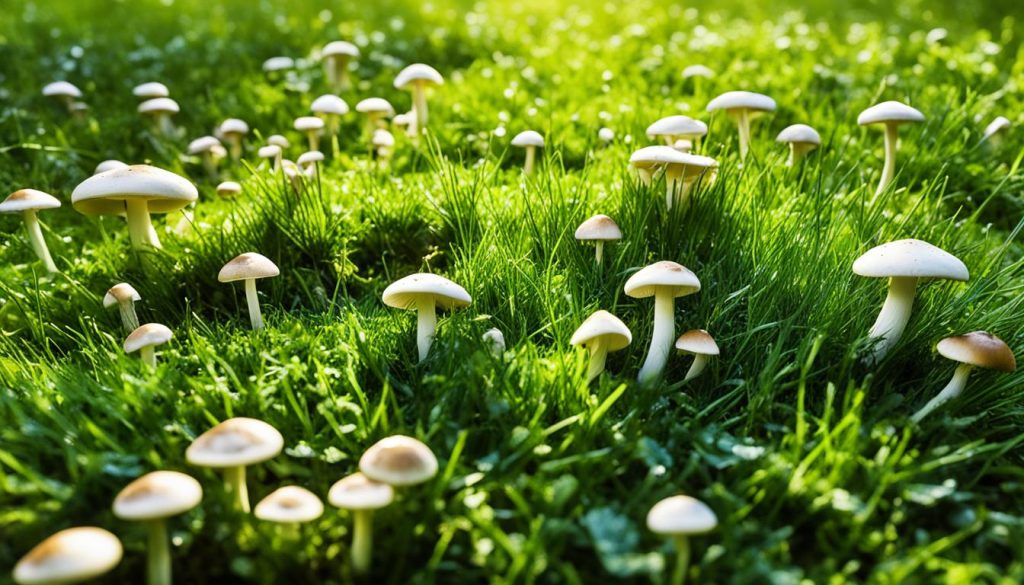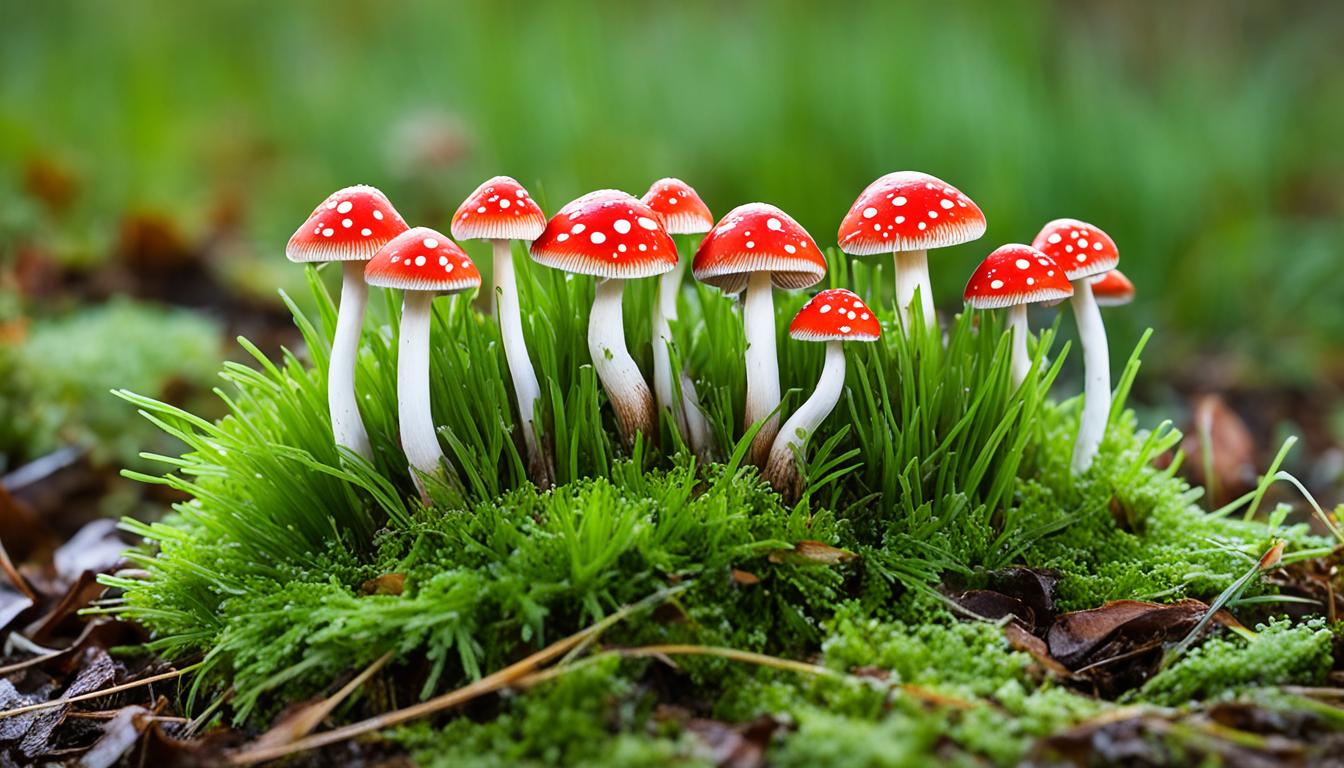Have you ever noticed mushrooms popping up in your lawn and wondered why they’re there? It’s a common occurrence that can leave homeowners puzzled. But fear not, there’s a simple explanation behind their presence. Let’s dive into the world of lawn mushrooms and uncover the reasons behind their growth.
Key Takeaways:
- Mushrooms in the lawn are caused by factors such as moisture, shade, and organic material in the soil.
- They are the reproductive structures of fungi and thrive in damp and shady areas.
- Mushrooms break down organic material, making the soil more productive.
- Trimming back branches, aerating the soil, and cleaning up after pets can help minimize mushroom growth.
- Overall, mushrooms indicate a healthy ecosystem and play a valuable role in lawn health.
Understanding Mushrooms in Lawns
Mushrooms in lawns can sometimes be a cause for concern, but they can also indicate a healthy ecosystem within your yard. These fungi are actually the visible reproductive structures of beneficial microbes that reside in the soil. They play a crucial role in breaking down organic matter and promoting overall soil health.
While mushrooms themselves are generally harmless, they can be unsightly and unwanted in a well-manicured lawn. To prevent or minimize mushroom growth, it is important to address the underlying causes that contribute to their appearance.
Causes of Lawn Mushrooms
Several factors can contribute to the growth of mushrooms in your lawn:
- Excessive moisture: Mushrooms thrive in damp environments, so poor drainage or over-watering can create the perfect conditions for their growth.
- Shade: Mushrooms prefer shady areas, so if your lawn has dense tree cover or shrubs that block sunlight, it can encourage mushroom growth.
- Organic debris: Decaying organic matter, such as dead roots, leaves, or stumps, can serve as a food source for mushrooms.
By addressing these underlying causes, you can help prevent the growth of mushrooms in your lawn.
Getting Rid of Lawn Mushrooms
If you want to remove mushrooms from your lawn, it’s important to keep in mind that simply plucking or mowing them down may not eliminate the problem entirely. Instead, focus on the following methods to prevent their recurrence:
- Improve drainage: Ensure that your lawn has proper drainage to prevent excess water accumulation, which can create a favorable environment for mushroom growth.
- Increase sunlight exposure: Trim back branches or remove any trees or shrubs that cast too much shade on your lawn to reduce mushroom growth.
- Remove organic debris: Regularly clean up dead leaves, roots, and other organic matter that can serve as a food source for mushrooms.
Implementing these preventive measures can help minimize the appearance of mushrooms in your lawn and maintain a healthier outdoor space.
The Benefits of Lawn Mushrooms
While mushrooms in the lawn may not be aesthetically pleasing, they actually provide some benefits to the overall health of the lawn. Mushrooms help break down organic material in the soil, improving its fertility and nutrient content. They also contribute to the natural cycle of decomposition and nutrient recycling. Therefore, instead of viewing mushrooms as a problem, they can be seen as indicators of a thriving and productive lawn ecosystem.
When mushrooms grow in the lawn, it means that the soil is rich in organic matter. These fungi play a vital role in breaking down dead plant material, including grass clippings, leaves, and roots. As the mushrooms feed on these organic remains, they release essential nutrients into the soil. This process enhances soil fertility, making it more conducive for grass growth. Ultimately, the presence of mushrooms reflects a healthy and balanced soil ecosystem.
Additionally, mushrooms contribute to the natural decomposition of organic matter. As they break down dead plant material, they release enzymes and chemicals that aid in the breakdown process. This decomposition process not only improves soil structure but also helps release trapped nutrients, making them available for the surrounding plants.
Furthermore, mushrooms play a role in nutrient cycling. As they decompose organic matter, they release nutrients like nitrogen, phosphorus, and potassium back into the soil. These nutrients are essential for the growth and development of a lush and vibrant lawn. By cycling nutrients, mushrooms contribute to the overall health and vitality of the grass.
It’s important to note that the presence of mushrooms in the lawn does not necessarily indicate a problem. In fact, it can be a sign of a well-balanced and healthy lawn ecosystem. While they may be unsightly, it’s essential to understand the benefits they bring to the soil and the overall health of the lawn.
| Benefits of Lawn Mushrooms |
|---|
| Break down organic material in the soil |
| Improve soil fertility and nutrient content |
| Aid in the natural cycle of decomposition and nutrient recycling |
| Contribute to the release of essential nutrients for grass growth |
| Enhance soil structure and nutrient availability |
By understanding and appreciating the benefits of lawn mushrooms, homeowners can develop a more holistic and sustainable approach to lawn care.

Dealing with Mushroom Growth
If you’re facing the issue of mushrooms in your lawn, there are effective steps you can take to address it. Here are some tips on dealing with mushrooms in the lawn:
1. Manual Removal
One of the simplest ways to tackle mushroom growth is by manually removing them. You can pluck or mow the mushrooms, ensuring you remove the entire structure. However, keep in mind that this method may not completely eliminate the problem, as the underlying conditions that favor mushroom growth may still be present.
2. Avoid Fungicides
While it may be tempting to use fungicides to get rid of mushrooms, it’s not recommended. Fungicides can harm the beneficial microbes and fungi in the soil, disrupting the natural balance of the ecosystem. It’s best to avoid using chemical treatments and focus on more natural solutions.
3. Address Underlying Causes
To effectively deal with mushrooms in your lawn, it’s crucial to address the root causes. Excessive moisture and shade are often the main contributors to mushroom growth. Here are some steps you can take:
- Improve Drainage: Ensure proper soil drainage by aerating the lawn and avoiding overwatering. This will help reduce moisture levels and create an environment less conducive to mushroom growth.
- Reduce Shade: Trim back branches and foliage from nearby trees and shrubs to increase sunlight exposure on the lawn. By reducing shade, you can discourage mushroom growth.
By tackling these underlying causes, you can create an environment that is less favorable to mushroom growth in the long run.
Remember, mushrooms in the lawn are generally harmless and indicate a healthy ecosystem. Focusing on creating a balanced and well-maintained lawn will help minimize mushroom growth over time.
| Methods to Deal with Mushrooms in the Lawn | Effectiveness |
|---|---|
| Manual Removal (plucking or mowing) | Partial, may not eliminate the problem completely |
| Avoiding Fungicides | Recommended to maintain the health of beneficial microbes and fungi |
| Improving Drainage | Highly effective in reducing moisture levels |
| Reducing Shade | Significantly decreases favorable conditions for mushroom growth |
Fairy Ring and Other Lawn Fungi
Lawn mushrooms come in various forms and can sometimes create eye-catching patterns in the grass. One such phenomenon is known as Fairy Ring, characterized by circular formations of mushrooms. These rings can range in size from a few inches to several feet in diameter.
The presence of Fairy Ring in your lawn is an indication of decaying wood or organic matter underground. As the fungi break down these materials, they release nutrients into the soil, promoting the overall health of your lawn. However, the indirect effects of Fairy Ring can include discoloration or die-out of the grass within the ring.
Managing Fairy Ring
To manage Fairy Ring, it is important to address the underlying cause, which is the decaying wood or organic matter. By removing buried wood or debris from the affected area, you can eliminate the food source for the fungi and prevent further growth. Additionally, improving soil conditions, such as ensuring adequate drainage and promoting aeration, can help discourage the formation of Fairy Ring.
It is important to note that not all lawn mushrooms are harmless. While most are beneficial and contribute to the overall health of your lawn, there are harmful fungal pathogens that can infect and damage the grass. Therefore, it is crucial to distinguish between harmless lawn mushrooms and harmful fungi to effectively manage and protect your lawn.

The image above showcases a beautiful example of Fairy Ring in a lawn. The circular formation of mushrooms adds a unique touch to the grass, but it is essential to understand the potential effects and take appropriate measures for management.
Can Dogs Eat Lawn Mushrooms?
While most lawn mushrooms are non-toxic, pet owners should exercise caution when it comes to dogs consuming these fungi. Some varieties of lawn mushrooms can be harmful and even poisonous to dogs. It’s essential to prioritize your pet’s well-being and take steps to prevent them from ingesting lawn mushrooms.
If you are unsure about the toxicity of a specific mushroom found in your lawn, it is recommended to consult with an expert or veterinarian. They can provide guidance and advise you on the best course of action to ensure your dog’s safety.
Remember, it is always better to err on the side of caution when it comes to your pets. By being proactive in preventing dogs from consuming lawn mushrooms, you can ensure their continued health and well-being.
The Role of Fungi in Lawn Health
Fungi play a crucial role in maintaining the overall health and vitality of lawns. These organisms contribute to the decomposition of organic matter, release essential nutrients back into the soil, and promote a diverse and balanced microbial ecosystem. Beneficial microbes, including fungi, enhance the resilience of lawns and support their growth.
One of the key functions of fungi in the lawn ecosystem is the breakdown of organic material. They feed on dead plant matter, such as fallen leaves and grass clippings, breaking them down into simpler compounds that can be absorbed by plants. This decomposition process helps to recycle nutrients and enrich the soil, providing the necessary elements for the healthy growth of the lawn.
Fungi also contribute to the development of a balanced microbial community in the soil. They form symbiotic relationships with plant roots, creating mycorrhizal associations. In these associations, fungi provide plants with nutrients, such as phosphorus and nitrogen, in exchange for sugars produced by the plants through photosynthesis. This mutually beneficial relationship enhances the nutrient uptake efficiency of plants and strengthens their resistance to environmental stresses.
To promote the growth of beneficial fungi in the lawn, it is important to provide favorable conditions. Incorporating organic material, such as compost or well-rotted manure, into the soil can increase the presence of beneficial microbes, including fungi. These additions help to improve soil structure, enhance nutrient availability, and create a favorable environment for the growth and activity of beneficial microorganisms.
To illustrate the role of fungi in the lawn ecosystem, here is a table summarizing the key benefits and functions they provide:
| Benefits of Fungi in Lawn Health | Functions |
|---|---|
| Promote nutrient recycling | Break down organic matter and release nutrients back into the soil |
| Enhance plant nutrient uptake | Form mycorrhizal associations with plant roots, facilitating nutrient exchange |
| Improve soil structure | Contribute to the formation of stable aggregates, enhancing water infiltration and aeration |
| Increase soil fertility | Contribute to the availability of essential elements for plant growth |
| Support overall lawn health | Help create a diverse and balanced microbial community, contributing to the resilience of the lawn |
By recognizing the vital role that fungi play in lawn health, homeowners can take steps to promote a thriving and sustainable lawn ecosystem. Ensuring adequate moisture, providing organic additions, and avoiding the use of harmful chemicals can help maintain a healthy balance of beneficial fungi and other microorganisms in the soil.
Embracing the Natural Cycle
Instead of viewing mushrooms as a problem, it can be beneficial to embrace them as part of the natural cycle in your lawn ecosystem. Mushrooms indicate a healthy soil with abundant organic matter. They contribute to the breakdown of organic materials and nutrient cycling, ultimately enriching the soil and supporting the growth of a lush and vibrant lawn. By understanding and respecting the natural processes at work in your lawn, you can create a more sustainable and harmonious environment.
When mushrooms appear in your lawn, it’s a sign that nature’s intricate network of organisms is thriving. These little fungi play a vital role in breaking down decaying matter, unlocking nutrients, and fostering a diverse ecosystem. Rather than viewing mushrooms as something to be eradicated, consider them as ambassadors of a healthy lawn. Their presence indicates that your lawn is benefiting from the natural processes that promote soil fertility and overall vitality.
The benefits of mushrooms in your lawn are numerous. Not only do they indicate soil health, but they also contribute to nutrient cycling. As mushrooms break down organic material, they help release valuable nutrients into the soil, making them accessible to your grass roots. This natural process enhances the fertility of the soil, promoting robust growth and overall resilience in your lawn.
| Benefits of Mushrooms in Lawn |
|---|
| Enhance soil fertility and nutrient content. |
| Contribute to the breakdown of organic matter. |
| Promote nutrient cycling and availability to grass roots. |
| Support a diverse and thriving lawn ecosystem. |
Additionally, mushrooms create a more diverse and balanced ecosystem in your lawn. They attract beneficial organisms like earthworms, which play a crucial role in soil aeration and improving drainage. This symbiotic relationship between mushrooms, earthworms, and other soil-dwelling creatures enhances the overall health of your lawn, promoting stronger grass growth, and reducing the risk of diseases.
By embracing the natural cycle in your lawn and allowing mushrooms to flourish, you can maintain a sustainable environment that supports the health and vitality of your lawn. Rather than trying to eliminate mushrooms, focus on creating optimal conditions for a balanced ecosystem. Ensure your lawn receives adequate sunlight, manage moisture levels appropriately, and provide regular organic matter inputs through composting or mulching. These practices will create a favorable environment for mushrooms and other beneficial organisms, leading to a healthier lawn in the long run.
Mushrooms and Lawn Ecosystem Resilience
In addition to their role in soil fertility and nutrient cycling, mushrooms also contribute to the resilience of your lawn ecosystem. By promoting a diverse and balanced microbial community in the soil, mushrooms help to naturally suppress harmful pathogens and diseases that can affect the grass. This resilience is crucial for maintaining a beautiful and healthy lawn, reducing the need for chemical interventions and promoting a more sustainable approach to lawn care.
So, next time you spot mushrooms in your lawn, take a moment to appreciate the natural processes at work. By embracing these little fungi and working with the ecosystem, you can create a thriving and vibrant lawn that is in harmony with nature.
Conclusion
In conclusion, mushrooms in lawns are a common occurrence and are typically a sign of a healthy ecosystem. While they may be unsightly, they play an important role in the decomposition of organic matter and contribute to improved soil fertility. By understanding the underlying causes of mushroom growth, such as excessive moisture, shade, and the presence of decaying organic material, homeowners can effectively manage their lawn’s mushroom population.
It is important to note that most lawn mushrooms are harmless and contribute to the overall health of the lawn. By working with the natural processes at play and embracing the benefits of fungi, homeowners can maintain a thriving and beautiful lawn. Rather than viewing mushrooms as a problem, they can be seen as indicators of a productive lawn ecosystem.
To minimize the appearance of mushrooms in the lawn, it is recommended to address the root causes, such as improving drainage, increasing sunlight exposure, and removing decaying organic matter. This approach not only manages mushroom growth but also promotes overall soil health and creates a more sustainable environment for the lawn.
In summary, while it is natural to be concerned about the presence of mushrooms in the lawn, understanding their role and taking appropriate steps to manage their growth can help homeowners maintain a healthy and vibrant outdoor space. By working with nature and embracing the benefits of mushrooms, homeowners can create a lawn that is both aesthetically pleasing and ecologically balanced.






[…] rings in grass are a natural phenomenon caused by a diverse group of soil-inhabiting fungi. These fungi grow outward in a circular pattern, which creates rings of lush, green growth, as well […]